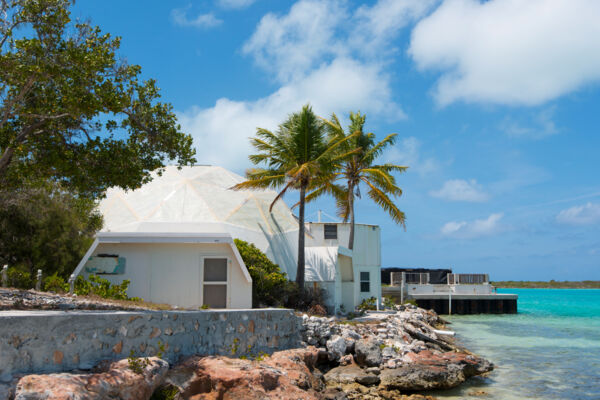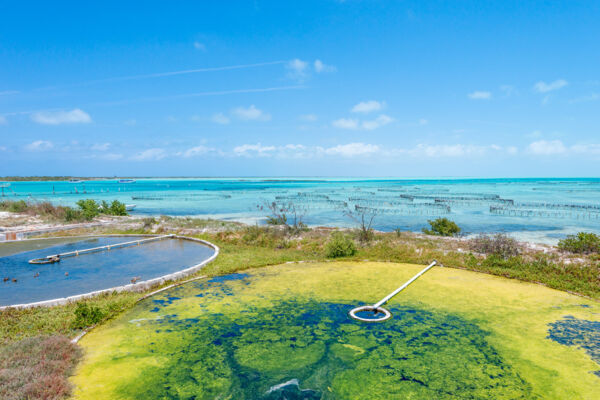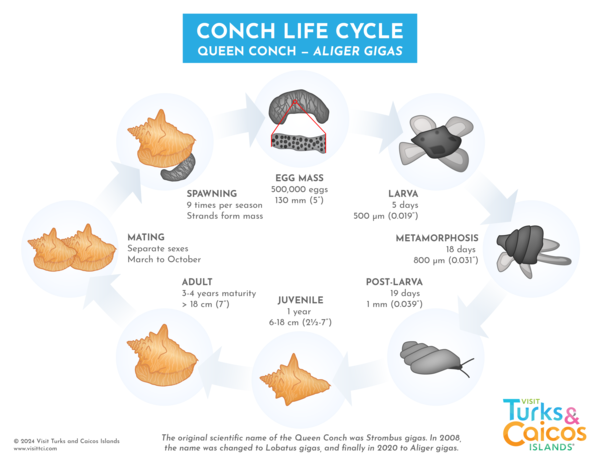Caicos Conch Farm
Providenciales
The Caicos Conch Farm on Providenciales is the world’s only conch farm. This educational site and functioning seafood farm offers a close-up look at the queen conch (Aliger gigas), and the unique process that was developed locally to raise these giant ocean snails.
At this attraction, you’ll see conchs of all sizes, the hatchery, algae vats that produce food for the conchs, and large ocean corrals in the shallow turquoise waters of Leeward Going Through Channel.
The stars of the attraction are Sally and Jerry, female and male pet conchs, which are on display for a hands-on show and tell.
In addition to the outdoor sights, there’s a gift shop on the premises which sells shells and a range of locally produced conch souvenirs such as jewelry and bowls.
One unique item you’ll learn about is the rare and beautiful treasure that is the conch pearl. These pearls may be brilliant pink, peach, white, and every shade in between. Shapes may be circular or oblong. Pearls can be found for sale at the Conch Farm and at some of the Grace Bay jewelry shops.
The Conch Farm has seen a bit of decline from what it once was. After Hurricane Ike struck the island in 2008, much of the facility was destroyed and commercial production has reduced significantly. The attraction aspect of the site still operates and is open for visitors.
Tours and Admission

Tours are individually guided small groups and take about 30 minutes. Admission cost is $12 for adults and $8 for children.
The Conch Farm is open Monday to Friday from 9:00 AM to 4:00 PM, and on Saturday from 9:00 AM to 2:00 PM. The site is closed on Sundays and holidays. All tours are guided and are suitable for all ages.
Getting to the Conch Farm
It’s quite simple to get to the Conch Farm, which is located at the Heaving Down Rock area of Providenciales.
Follow the central Leeward Highway east to its conclusion at the Grace Bay roundabout. The highway that continues east from this point is the two-lane paved Long Bay Highway, yet many refer to it as Leeward Highway as well.
You’ll find the Conch Farm near the end of Long Bay Highway, and close to Heaving Down Rock Marina (where the North Caicos passenger ferry departs). Look for a sign on your right. The entrance to the Conch Farm is 500 feet (150 m) before the marina. You’ll know you’re at the correct place when you see mountains of white conch shells!
Several of the island tours available on Providenciales include a stop at the Conch Farm.
The Process

See Conch - A National Symbol for more information on the history and life cycle of the queen conch. This giant mollusk is a staple of our local cuisine, and factors into conch salad, conch fritters, stews, and other favorite dishes.
The farming process starts with collecting egg masses in the wild. In the wild, on average only one egg out of the 500,000 in an egg mass matures into an adult. Raising the eggs in a controlled environment leads to a greatly improved success rate.
In the hatchery building, the eggs are hatched, and metamorphosis from larvae into post-larva, when they essentially become recognizable conchs that are about 1/24” of an inch in length (1 mm).
After they’ve grown, they are transferred outside into pans until they become juveniles (approximately one year). Finally, the conchs are placed into large pens that are cordoned-off in the ocean. It takes 3-4 years for a conch to mature.
The conchs are fed a mixture of algae (grown on-site), imported feed, and by-product grains from the local Turk's Head Brewery.

History of the Conch Farm
The Caicos Conch Farm was started in 1984 by Chuck Hesse, a retired U.S. Navy Officer and marine biologist. He pioneered methods to raise conch commercially, which helped relieve pressure on the wild stocks. The farm raises Queen Conch (strombus gigas), the common species of conch eaten in the islands.
In many Caribbean and tropical Atlantic countries, wild conch populations have seen a significant decline due to overfishing. In response, many nations have enacted quotas and fishing seasons.
The Turks and Caicos has had an interesting history with raising marine products, and crab farming and sea sponge farming also took place in the islands. As is the case with the Conch Farm, the natural channels and lagoons in the country were ideally suited locations and were adapted for the task.
As is also the case with the conch, lobster, and fish caught by the local small-scale fishing operations, the Conch Farm’s seafood is both distributed locally and internationally.
Future
The Caicos Conch Farm is switching focus from conch farming to fish farming. At this time, it’s not sure if commercial conch farming will continue long-term.
